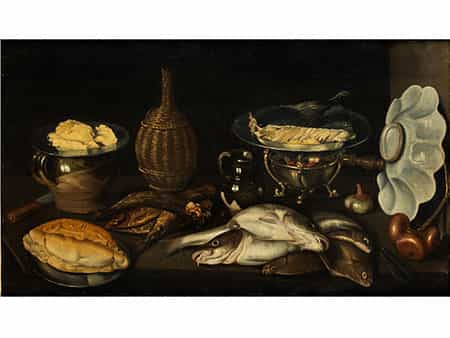Your search for Paolo Antonio Barbieri in the auction
16th - 18th century paintings
Thursday, 22 September 2016
» reset
Your personal art agent

You are interested in works by Paolo Antonio Barbieri?
We are happy to inform you, if works by Paolo Antonio Barbieri are to be auctioned in one of our upcoming auctions.
Please accept our privacy policy
934
Paolo Antonio Barbieri,
1603 Cento – 1649
STILLLEBEN MIT FISCHEN, BROT, ZWIEBELN,
EINER WEINFLASCHE UND GESCHIRR Öl auf Leinwand.
60 x 105 cm.
Catalogue price € 30.000 - 50.000
Catalogue price€ 30.000 - 50.000
$ 32,400 - 54,000
£ 27,000 - 45,000
元 234,600 - 391,000
₽ 2,984,700 - 4,974,500
Paolo Antonio Barbieri, der Bruder von Guercino, verdankt es dem Werk „Felsina pittrice” von Carlo Cesare Malvasia (Bologna 1678), eine der historischen Hauptquellen zur emilianischen Malerei des 17. Jahrhunderts, dass sich die moderne Kunsthistorik seiner adäquat erinnert. In besagtem Werk wird er als exzellenter Spezialist für Stilleben erwähnt („Non avea paragone...nella pittura rappresentante frutti, fiori e animali” – Seine Darstellungen von Fruchten, Blumen und Tieren waren unvergleichlich). Paolo Antonio Barbieri galt lange Zeit nur als Kurator des Libro dei conti (dt. Auftragsbuch) der vom Bruder geführten Werkstätten. Nach und nach wurde ihm jedoch eine künstlerische Eigenständigkeit zuerkannt, besonders nach dem Bekanntwerden der Spezieria (dt. Gewürzhandlung) die er 1637 malte, die heute in der Pinacoteca Comunale in Spoleto zu sehen ist, ein Werk, das ihn zu einem der besten Stillebenmaler der Emilia des Seicento machte. Im „Libro dei conti” sind übrigens viele seiner Stilleben aufgelistet (die äußerst gut bezahlt wurden), davon neun, die – ebenso wie bei unserem Werk – Fische darstellten (leider sind die Beschreibungen zu wenig detailliert, als dass man daraus Rückschlüsse auf bekannte Gemälde ziehen könnte).
Dieses schöne Werk zeigt Paolo Antonio Barbieris ganze Kunstfertigkeit, seinen eigenen, unaufdringlichen, aus direkten Naturstudien gewonnenen Realismus und seine charakteristische Darstellung der auf einem Tisch gleichsam zufällig liegenden Objekte, die keinen logischen oder strukturellen Bezug zum Ganzen zu haben scheinen, jedoch eine authentische, monumentale Komposition ermöglichen. Auch hier lassen sich die für Barbieri typischen Einflüsse erkennen, zum einen das römische Stilleben der Zeit nach Caravaggio, zum anderen die lombardischen Stilleben des beginnenden Seicento, von einzelnen raren Werken dieses Genres von Empoli, bis hin zu den zeitgenössischen spanischen und flämischen „bodegones”. Um die Autorenschaft Barbieris zu untermauern (wie dies bereits Sir Denis Mahon sehr überzeugend tat), bietet es sich an folgende Werke des Künstlers zum Vergleich heranzuziehen, so zum Beispiel „Natura morta con cestino di castagne“ (Art Institute of Chicago) oder das Stilleben „Äpfel, Zwiebeln, Knoblauch, Kürbisse und Zweige”, das in der Pinacoteca Comunale in Ravenna zu sehen ist.
Literatur:
J. Bentini, scheda in Il bello dei butti. Rifiuti e ricerca archeologica a Faenza tra Medioevo e età moderna, a cura di C. Guarnieri, Ausstellungskatalog Faenza 2009, Quaderno di archeologia dell’Emilia Romagna”, 24, Florenz 2009, S. 147-148. (1070901) (21)
Paolo Antonio Barbieri,
1603 Cento - 1649
STILL LIFE WITH FISH, BREAD, ONIONS, A BOTTLE OF WINE AND TABLEWARE
Oil on canvas.
60 x 105 cm.
Guercino's brother, Paolo Antonio Barbieri, owes his rightful place in modern art history to the work Felsina pittrice by Carlo Cesare Malvasia (Bologna 1678), one of the main historical sources on 17th century Emilian painting. In this text Barbieri is mentioned as an excellent specialist of still life painting (“Non avea paragone...nella pittura rappresentante frutti, fiori e animali”). The Libro dei conti lists many of his still lifes, for which very high sums were paid, and nine of them depict fish - just like the offered painting. This beautiful work showcases all of Paolo Antonio Barbieri's artistry and subtle realism gained from first-hand studies of nature and his characteristic depiction of objects lying in a seemingly random arrangement on a table. Barbieri's authorship is further underpinned, (as Sir Denis Mahon already convincingly did), through a comparison with works such as Kitchen Still Life (Art Institute of Chicago) or the still life Apples, Onions, Garlic, Pumpkins and Twigs (Pinacoteca Comunale, Ravenna).
Literature:
J. Bentini, scheda in Il bello dei butti. Rifiuti e ricerca archeologica a Faenza tra Medioevo e età moderna, a cura di C. Guarnieri, exhibition catalogue Faenza 2009, Quaderno di archeologia dell’Emilia Romagna”, 24, Florence 2009, p. 147-148.
This object has been individually compared to the information in the Art Loss Register data bank and is not registered there as stolen or missing.
Your personal art agent
You would like to be informed of upcoming auctions if a work by Paolo Antonio Barbieri is offered? Activate your personal art agent here.
Please accept our privacy policy
You would like to purchase a work by Paolo Antonio Barbieri?
Your personal art agent Purchase in Private Sale Calendar
Our experts are happy to support you personally in your search for art objects.
You would like to sell a work by Paolo Antonio Barbieri?
Consign now Private Sale Service FAQ
Your consignments are always welcome.
Our staff will be happy to personally assist you every step of the way. We look forward to your call.
Get in touch with our experts
further catalogues Furniture & Interior | Sculpture & Works of art | Silver & Porcelain | Two collections of ivory objects | Boxes & Miniatures | Russian art | 19th century paintings | Modern & Contemporary art | Asian art | Wristwatches & Clocks | Bags & luggage | 16th - 18th century paintings | Jewellery | Hampel Living












